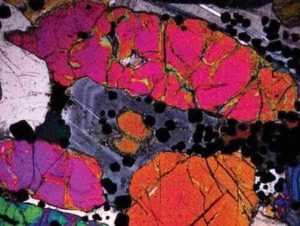
Research carried out by scientists at Keele University, the University of Manchester and University College Dublin has shed new light on how precious metals are concentrated in igneous rocks.
The solidified remains of sub-volcanic magmatic intrusions host the greatest concentrations of platinum-group metals in the Earth’s crust, such as platinum, palladium and rhodium. Scientists refer to these bodies as layered mafic intrusions. Traditional models suggest that these layered intrusions form in large volume magma chambers, but this new research has found that it’s more likely small amounts of magma is repeatedly injected into a crystal mush.
The research, published in Nature Geoscience, demonstrates the case for re-evaluation of the long-held belief about how layered mafic intrusions are formed.
The research involved carrying out a detailed study on an approximately 60 million year old extinct volcano on the island of Rum in northwest Scotland. Mineral crystals in the Rum intrusion were analysed using a novel microsampling approach, to identify isotopic variations of the element strontium.
The measured strontium isotope variations provide evidence that crystallization of the minerals in and around precious-metal rich layers occurred within 10s to 100s of years. The data also show that layered intrusions such as on Rum form by repeated self-intrusion of magma during solidification rather than by protracted cooling from the bottom up and the top down.
This new insight has important implications for the understanding of precious-metal mineralization in mafic igneous systems more generally.
Keele University’s Dr. Ralf Gertisser, Reader in Mineralogy and Petrology in Keele’s School of Geography, Geology and the Environment, said: “The study significantly influences our understanding of how layered intrusions and the precious metal deposits within them form.”
Dr. Luke Hepworth, former Ph.D. student in the School of Geography, Geology and the Environment at Keele University, added: “There is scope for the model proposed here to be extrapolated to precious-metal-bearing rocks in larger, economically significant layered mafic intrusions such as the Bushveld Complex in South Africa and the Stillwater Complex in the U.S..”
Dr. Brian O’Driscoll, Senior Lecturer in Petrology at The University of Manchester, said: “These new data highlight that the crystallization of layered intrusions and their associated platinum-group metal mineralization may be a dynamic and rapid process. It will be exciting to see whether these ideas can be extended to other economically-important deposits in the future.”
Reference:
Luke N. Hepworth et al. Rapid crystallization of precious-metal-mineralized layers in mafic magmatic systems, Nature Geoscience (2020). DOI: 10.1038/s41561-020-0568-3
Note: The above post is reprinted from materials provided by Keele University.










